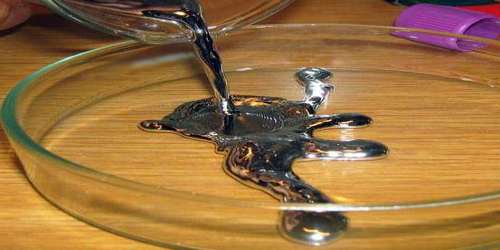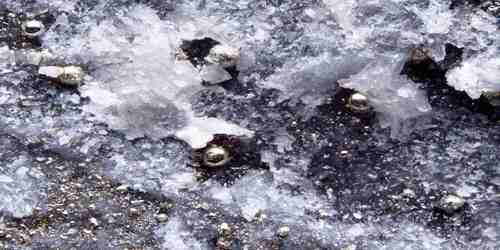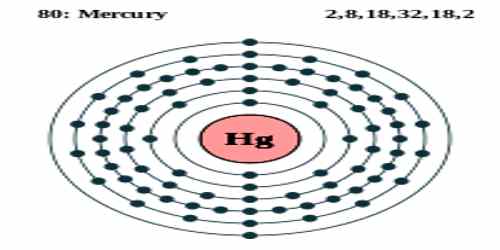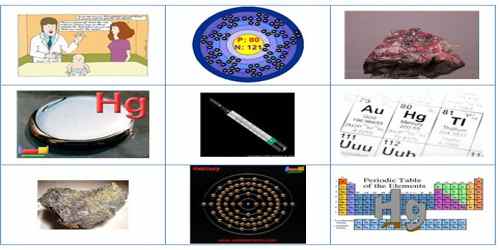Mercury
Definition
Mercury is a silvery-white, dense, poisonous metallic element that is a liquid at room temperature and is used in thermometers, barometers, batteries, and pesticides. It occurs in deposits throughout the world mostly as cinnabar (mercuric sulfide). The red pigment vermilion is obtained by grinding natural cinnabar or synthetic mercuric sulfide. Its atomic number 80; atomic weight 200.59; melting point -38.87°C; boiling point 356.58°C; specific gravity 13.546 (at 20°C); valence 1, 2.

Like a few other elements, mercury has a chemical symbol, Hg that bears no resemblance to its name. This is because Hg is an abbreviation of the Latin name of the element, which was hydrargium. This word in turn was taken over from Greek, where it literally meant “water-silver.”
Elemental or metallic mercury is a shiny, silver-white metal and is liquid at room temperature. It is used in older thermometers, fluorescent light bulbs and some electrical switches. When dropped, elemental mercury breaks into smaller droplets which can go through small cracks or become strongly attached to certain materials. At room temperature, exposed elemental mercury can evaporate to become an invisible, odorless toxic vapor. If heated, it is a colorless, odorless gas.
Mercury is used in thermometers, barometers, manometers, sphygmomanometers, float valves, mercury switches, mercury relays, fluorescent lamps and other devices, though concerns about the element’s toxicity have led to mercury thermometers and sphygmomanometers being largely phased out in clinical environments in favor of alternatives such as alcohol- or galinstan-filled glass thermometers and thermistor- or infrared-based electronic instruments.

Occurrences and Properties of Mercury
Mercury occurs in Earth’s crust on the average of about 0.08 gram (0.003 ounce) per ton of rock. The principal ore is the red sulfide, cinnabar. Native mercury occurs in isolated drops and occasionally in larger fluid masses, usually with cinnabar, near volcanoes or hot springs. Over two-thirds of the world supply of mercury comes from China, with most of the remainder coming from Kyrgyzstan and Chile; it is often a by-product of gold mining. Extremely rare natural alloys of mercury have also been found: moschellandsbergite (with silver), potarite (with palladium), and gold amalgam.
Natural mercury is a mixture of seven stable isotopes: 196Hg (0.15 percent), 198Hg (9.97 percent), 199Hg (16.87 percent), 200Hg (23.10 percent), 201Hg (13.18 percent), 202Hg (29.86 percent), and 204Hg (6.87 percent). As a wavelength standard and for other precise work, isotopically pure mercury consisting of only mercury-198 is prepared by neutron bombardment of natural gold, gold-197.

Mercury is a heavy, silvery-white liquid metal. Compared to other metals, it is a poor conductor of heat, but a fair conductor of electricity. It has a freezing point of −38.83 °C and a boiling point of 356.73 °C, both the lowest of any metal. Upon freezing, the volume of mercury decreases by 3.59% and its density changes from 13.69 g/cm3 when liquid to 14.184 g/cm3 when solid. The coefficient of volume expansion is 181.59 × 10−6 at 0 °C, 181.71 × 10−6 at 20 °C and 182.50 × 10−6 at 100 °C (per °C). Solid mercury is malleable and ductile and can be cut with a knife.
Mercury does not react with most acids, such as dilute sulfuric acid, although oxidizing acids such as concentrated sulfuric acid and nitric acid or aqua regia dissolve it to give sulfate, nitrate, and chloride. Like silver, mercury reacts with atmospheric hydrogen sulfide. Mercury reacts with solid sulfur flakes, which are used in mercury spill kits to absorb mercury.

Applications and Effects of Mercury
The use of mercury in the manufacture of chlorine and caustic soda (sodium hydroxide) by electrolysis of brine depends upon the fact that mercury employed as the negative pole, or cathode, dissolves the sodium liberated to form a liquid amalgam. An interesting application, though not of great commercial significance, is the use of mercury vapour instead of steam in some electrical generating plants, the higher boiling point of mercury providing greater efficiency in the heat cycle.

Mercury and its compounds have been used in medicine, although they are much less common today than they once were, now that the toxic effects of mercury and its compounds are more widely understood.
Mercury becomes a problem for the environment when it it is released from rock and ends up in the atmosphere and in water. These releases can happen naturally. Both volcanoes and forest fires send mercury into the atmosphere.
Human activities, however, are responsible for much of the mercury that is released into the environment. The burning of coal, oil and wood as fuel can cause mercury to become airborne, as can burning wastes that contain mercury.
Reference:
















